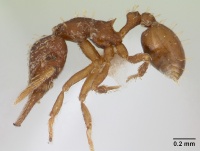Strumigenys infidelis
| Strumigenys infidelis | |
|---|---|

| |
| Scientific classification | |
| Kingdom: | Animalia |
| Phylum: | Arthropoda |
| Class: | Insecta |
| Order: | Hymenoptera |
| Family: | Formicidae |
| Subfamily: | Myrmicinae |
| Tribe: | Attini |
| Genus: | Strumigenys |
| Species: | S. infidelis |
| Binomial name | |
| Strumigenys infidelis Santschi, 1919 | |
Known from a cloud forest and plantain planting.
Identification
Bolton (2000) - A member of the Strumigenys louisianae-group. Material of this species is sparse. S. infidelis has the same preapical dentition and the deep narrow postbuccal groove seen in Strumigenys louisianae, but lacks the flagellate humeral hairs of that species. For this reason I have revived infidelis from the synonymy of louisianae where Brown (1962b) left it.
Keys including this Species
Distribution
Latitudinal Distribution Pattern
Latitudinal Range: 10.35722222° to -64.3°.
| North Temperate |
North Subtropical |
Tropical | South Subtropical |
South Temperate |
- Source: AntMaps
Distribution based on Regional Taxon Lists
Neotropical Region: Argentina (type locality), Bolivia, Brazil, Venezuela.
Distribution based on AntMaps
Distribution based on AntWeb specimens
Check data from AntWeb
Countries Occupied
| Number of countries occupied by this species based on AntWiki Regional Taxon Lists. In general, fewer countries occupied indicates a narrower range, while more countries indicates a more widespread species. |

|
Estimated Abundance
| Relative abundance based on number of AntMaps records per species (this species within the purple bar). Fewer records (to the left) indicates a less abundant/encountered species while more records (to the right) indicates more abundant/encountered species. |

|
Biology
|
Castes
Nomenclature
The following information is derived from Barry Bolton's Online Catalogue of the Ants of the World.
- infidelis. Strumigenys infidelis Santschi, 1919f: 48 (w.) ARGENTINA. Junior synonym of louisianae: Brown, 1953g: 28; revived from synonymy: Bolton, 2000: 523.
Unless otherwise noted the text for the remainder of this section is reported from the publication that includes the original description.
Description
Worker
Bolton (2000) - TL 2.0-2.2, HL 0.50-0.54, HW 0.44-0.46, CI 85-88, ML 0.28-0.29, MI 52-56, SL 0.29-0.31, SI 66-67, PW 0.24-0.27, AL 0.52-0.55 (3 measured).
Mandible without a denticle proximal to the preapical tooth. With head in profile postbuccal groove narrow and deeply incised. Apicoscrobal hair short and stiff, remiform. Cephalic dorsum with a single pair of short standing hairs, close to occipital margin. Pronotal humeral hair narrowly remiform; mesonotal standing hairs remiform, broader than humeral hairs. Ventral surface of petiole without trace of spongiform tissue.
Type Material
Bolton (2000) - Syntype workers, ARGENTINA: La Plata (Bruch) (Museu de Zoologia da Universidade de Sao Paulo) [examined].
References
- Albuquerque, E., Prado, L., Andrade-Silva, J., Siqueira, E., Sampaio, K., Alves, D., Brandão, C., Andrade, P., Feitosa, R., Koch, E., Delabie, J., Fernandes, I., Baccaro, F., Souza, J., Almeida, R., Silva, R. 2021. Ants of the State of Pará, Brazil: a historical and comprehensive dataset of a key biodiversity hotspot in the Amazon Basin. Zootaxa 5001, 1–83 (doi:10.11646/zootaxa.5001.1.1).
- Bolton, B. 2000. The ant tribe Dacetini. Memoirs of the American Entomological Institute. 65:1-1028. (page 523, revived to species)
- Brown, W. L., Jr. 1953g. Revisionary studies in the ant tribe Dacetini. Am. Midl. Nat. 50: 1-137 (page 28, junior synonym of louisianae)
- Brown, W. L., Jr. 1962c. The neotropical species of the ant genus Strumigenys Fr. Smith: synopsis and keys to the species. Psyche (Camb.) 69: 238-267 (page 247, junior synonym of louisianae)
- Santschi, F. 1919f. Nouveaux formicides de la République Argentine. An. Soc. Cient. Argent. 87: 37-57 (page 48, worker described)
References based on Global Ant Biodiversity Informatics
- Bolton, B. 2000. The Ant Tribe Dacetini. Memoirs of the American Entomological Institute 65
- Fernandes I., and J. de Souza. 2018. Dataset of long-term monitoring of ground-dwelling ants (Hymenoptera: Formicidae) in the influence areas of a hydroelectric power plant on the Madeira River in the Amazon Basin. Biodiversity Data Journal 6: e24375.
- Fernández, F. and S. Sendoya. 2004. Lista de las hormigas neotropicales. Biota Colombiana Volume 5, Number 1.
- Rodriguez E. R., and J. E. Lattke. 2012. Diversidad de hormigas en un gradiente altitudinal de la cordillera de la Costa, Venezuela. Boletín de la Sociedad Entomológica Aragonesa (S.E.A.) 50: 295?304.
- Silva T. S. R., and R. M. Feitosa. 2019. Using controlled vocabularies in anatomical terminology: A case study with Strumigenys (Hymenoptera: Formicidae). Arthropod Structure and Development 52: 1-26.

